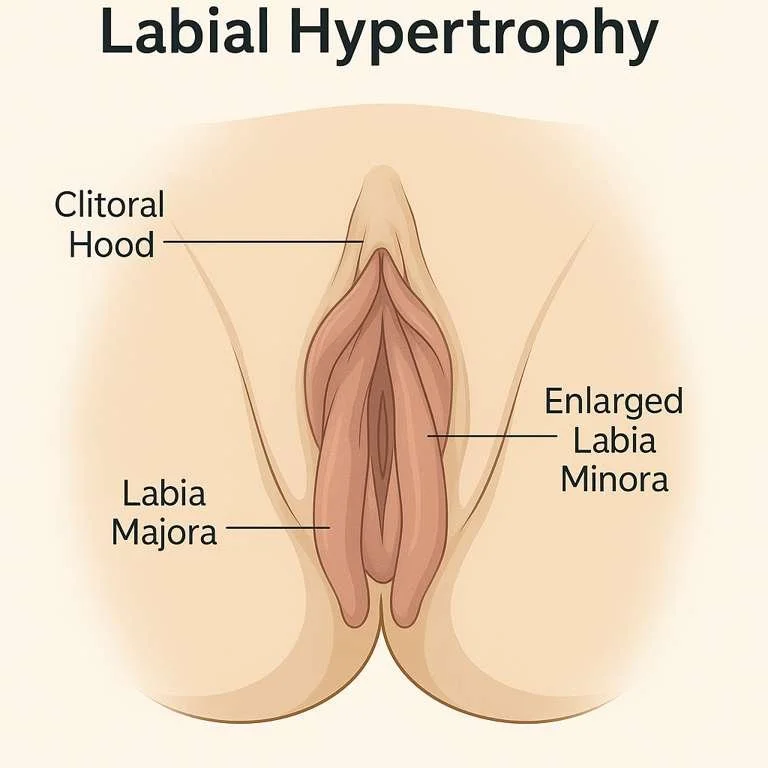Labial Hypertrophy: What It Is and When Surgery Helps
If you’ve ever felt discomfort from your labia or noticed they appear longer, thicker, or asymmetrical, you may have come across the term labial hypertrophy. It sounds clinical, but it refers to something many women experience, and often suffer from in silence.
This article explains what labial hypertrophy is, how it affects your daily life, what causes it, and when surgical treatment may be the right option.
What Is Labial Hypertrophy?
Labial hypertrophy is the medical term for an increase in the size or prominence of the labia minora or labia majora. It’s not a disease or a diagnosis, but rather a descriptive term. In most cases, the condition affects the labia minora, the inner lips of the vulva, which may protrude significantly past the outer lips.
Hypertrophy can be:
Unilateral (one side larger than the other)
Bilateral (both sides enlarged)
Asymmetrical (uneven or irregular)
This condition can be present at birth or develop later due to hormonal changes, physical activity, childbirth, or aging. Although it's not dangerous, it may lead to discomfort, insecurity, or hygiene issues.
Common Symptoms and Concerns
Many women with labial hypertrophy notice some of the following:
Friction or tugging during exercise
Pain during sex
Irritation or sensitivity in tight clothing
Difficulty maintaining hygiene
Embarrassment in fitted underwear or swimsuits
Feeling of bulkiness or “extra skin” in the vaginal area
These symptoms are valid and often disruptive. While labial hypertrophy is common and varies widely in appearance, that does not mean you need to live with discomfort.
What Causes Labial Hypertrophy?
There is no single cause, but the most common contributors include:
1. Genetics
Some women are simply born with larger or more prominent labia. This is normal and not a medical problem unless it causes physical or emotional discomfort.
2. Hormonal Changes
Puberty, pregnancy, and menopause can all change the appearance of labial tissue. Hormonal fluctuations affect skin elasticity, volume, and pigmentation.
3. Childbirth or Trauma
Vaginal delivery may stretch the labia or cause minor tears. These can heal in uneven ways, leaving one side longer or thicker than before.
4. Aging and Skin Laxity
As skin loses elasticity, the labia can appear longer, thinner, or more wrinkled. For some women, this creates friction or folding during activity.
Is Treatment Always Necessary?
Not at all. Labial hypertrophy is often harmless. If you have no discomfort, functional issues, or insecurity, there is no reason to treat it.
But if it interferes with movement, causes irritation, or affects your confidence, there are effective treatment options available.
Surgical Treatment: Labia Reduction Surgery
The most effective solution for symptomatic hypertrophy is labiaplasty, also known as labia minora reduction surgery. The procedure removes excess tissue, reshapes the labia, and improves balance between the sides. It can be performed under local or general anesthesia and is often completed in under an hour.
Women often choose labiaplasty when they are experiencing:
Persistent irritation during workouts
Pain during intercourse
Ongoing hygiene or moisture problems
Frustration with bulging or visible tissue in clothing
You can learn more about labiaplasty surgery in Torrance at Adonis Plastic Surgery, including consultation details and treatment planning.
Recovery and Results
Most patients return to light activity within 3 to 5 days and resume normal exercise or sexual activity after 4 to 6 weeks. Mild swelling, bruising, and sensitivity are common in the first week.
Once healed, the results are permanent. Patients report improved comfort, easier clothing choices, and more confidence during intimacy.
What About Cost?
Labial hypertrophy surgery cost can vary depending on the provider, location, and type of anesthesia used. At Adonis Plastic Surgery, our pricing is transparent and includes consultation, anesthesia, surgery, and follow-up care.
In general, labiaplasty for hypertrophy ranges from $3,000 to $6,000. Payment plans and financing options are available to make treatment accessible.
Emotional Benefits of Treatment
For many women, labial hypertrophy is not just physical, but it’s also emotional. Being able to move comfortably, wear what you want, and stop worrying about being seen or judged brings relief. Some women describe it as finally feeling “normal” again after years of frustration or shame.
You deserve to feel comfortable in your body without discomfort, limitation, or constant second-guessing.
Final Thoughts
Labial hypertrophy is more common than most people think, and treatment is not about vanity. It is about comfort, confidence, and the ability to move through your life without irritation or worry.
At Adonis Plastic Surgery, we offer discreet, supportive consultations and personalized care. Whether your labia are naturally large, asymmetrical, or stretched from life changes, we are here to help you feel comfortable again.


